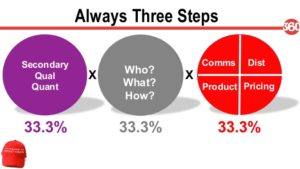When marketing is a cost centre
Or how the marketers became paper salesmen and the key competences on the company direction took over their colleagues from other disciplines.
It happens to the more experienced, too, that we let ourselves manoeuvre into the situation in which we talk about a marketing budget long before it can be defined how much our funny colleagues-marketers contribute to our business target. It originates from the times not long gone when some marketers could dream as they liked, as they had a very little say in key decision making, and every penny, they wished to use to prepare a dinner for key customers, photo shoot or PPC campaign, had to lengthily argue over with the real management.
Transition to zero-based budgeting is stressing, in any case. To wake up one day to find out there isn’t a penny for marketing available. No allocated budget with comfortable cushion for four decent campaign and few small ones. Along with a continual budget for social networks, PPC, graphics, copyrights, CMS, radio and something for smaller productions. And suddenly not a penny more. At least, one can only blame themselves. Finally, to take the plunge and make a long postponed resolution lying in one’s head come true. Also to smash this idea of some colleagues that the company could thrive and grow, even if there were no Facebook, Instagram, Adwords or YouTube.
And outright count with the fact that like all ambitious plans, not all can be done in time, originally dedicated to it. You know, to get the key people from all departments together at company parties and what more, to provoke a little bit of activity in them is no fun. It will happen, after all, in days or more likely in weeks later. By that time, not only a larger part of company roughly knows, but also believes that the marketing has actually quite crucial relevance for company’s functioning. Still, a primary goal is something slightly different. The primary goal is start investing money into the marketing, not spending. In short, to know very well which marketing activity contributes to the business targets which originate from the company’s get-togethers. To plan campaigns with a clear awareness of what leads where and what sense it makes. To define not just in outlines, but with full knowledge of what marketing activity can help the brand metrics, how these brand metrics will in a long-term plan transform into the business results. To establish, along with this all, what marketing channels one uses and what value for money ratio one achieves.
Everyone somewhat guesses how did we get to beforehand planned marketing budgets, back then. Like with many other things, it all comes to the mental laziness, comfiness and laziness, again. To change things, you know, when they work has been always tricky. On the other hand, this is the way how the marketing department becomes a cost centre in the eyes of people from other departments. A centre that delivers on average, consuming resources above average.
And even if we wouldn't mind it for some time, we would find it a little bit sad if we suddenly found ourselves being unwanted, quietly tolerated and sadly insignificant.
So hit it hard and perhaps you’ll find out that the zero-based budget can result in even bigger budget!
Marketing ≠ communication
Everybody knows marketing communication. However, do we really have to consider it as the only important part of marketing?
What marketing is and is not.
Great deal of us read some marketing definitions at college or university and then passed respective exams. These marketing theory definitions have been with us for more than fifty years, so we will remind you of them.
According to the American Marketing Association, marketing is the activity, set of institutions, and processes for creating, communicating, delivering, and exchanging offerings that have value for customers, clients, partners, and society at large.
Keisha M. Cutright, Assistant Professor of Marketing at The Wharton School in Pennsylvania, USA, says that we can consider marketing as an independent organisational unit or as a set of processes focused on understanding the customers and meeting their needs.
Among these issues, there belongs often a decision about what products to make, where to sell them, how to promote them and what are their prices.
Although these principals are more than fifty years old, as mentioned above, nothing about them has changed still. It is not primarily about the product, as many think, it is about the customers and their needs.
That is why we need to realise one thing, closely related, that marketing ≠ communication.
What is communication?
Communication cannot be described simply as an advertisement (ATL, BTL), digital, PR, events and much more. It is a vital part of marketing, the most visible one, but it is still only its part. The communication itself is preceded by a lot of important work that matters in practice the most.
Why is it wrong?
Our little marketing pool mostly tries to figure out what campaign it is doing with no worked out segmentation, knowing nothing about the customers’s motives, not thinking about the product itself, its price, and without a proper strategy to roof it all up for a period longer than the actual three month campaign. Unfortunately, then it happens that the campaign is nice, but useless. Business either stagnates or even goes down. The market share doesn’t move or we even plummet. As we don’t execute surveys, we don’t know if the brand awareness is going up or down, not to mention other useful metrics. And one of the reasons is our approach when we do only communication.
Is it because of the fact that other parts of marketing are boring, or they are not seen, and then we have nothing to boast about at the conferences? Or there is a large number of agencies and they make their clients simply do? Or the Czech marketers don’t have such know-how and have now idea how to work with marketing?
The reasons will be countless, which we can study indefinitely, or we can inspire ourselves by successful approaches, proven in practice and yielding results. Mark Ritson promotes one such interesting approach.
What does such strategy looks like?
Mark Ritson is a professor Adjunct Professor of Marketing at Melbourne Business School, a marketer, who has experience with working for the biggest brands (LVMH, GSK, Pepsico etc.).
Last but not least, he is an excellent speaker who can get attention even from the biggest sleepers of marketing events through his presentations and appearances. To simplify, we can describe this marketing approach in three steps. Analysis, strategy, tactics.
Analysis
The basis is understanding the market and creation of segmentation. Segmentation is not targeting. Segmentation has nothing to do with brand or society. Segmentation can be described as an objective classification of target audiences in the market. Interesting enough, if the competition has the same target audience and does it all right, the same segmentation is achieved. At this stage, we have to find out too, what the customers think. We begin with quantitative research, and the acquired data then verify with qualitative research. Let’s forget what we marketers think and let us listen to the customers.
Strategy
The magical word “strategy” is to mainly define what we will and we will not do over next twelve months. How we will aim based on each segment (typical mistake is - we aim at all). We must set narrow but distinct positioning within the market, coming from where we will stand firm or where not, and what is our goal to represent to the consumer. Lastly, we set clear, measurable, strategic goals for a period not longer than twelve months. At the same time, we can use three simple questions - Who? What? How?
Tactics
Final part of marketing concerns the product development, price formation, distribution and then our favourite discipline - communication. Here we must add, mathematically the communication is only eight percent of marketing. On the top of that, at the end of the whole process. Every area is clearly defined and builds on previous steps. Practically, we can say we still do marketing without communication, and it even delivers. The most important about it is that if we mess up step one or two, we do such communication in vain, as it won’t simply work.
Conclusion
This approach is not an easy one, it requires much work, much persuasion, be it the colleagues, superiors and many other people from the industry who will stubbornly claim that communication = marketing. Let us use follow the principals defined decades ago and are constant. Everything is about the customer, their motives and the ways how to meet their need.




